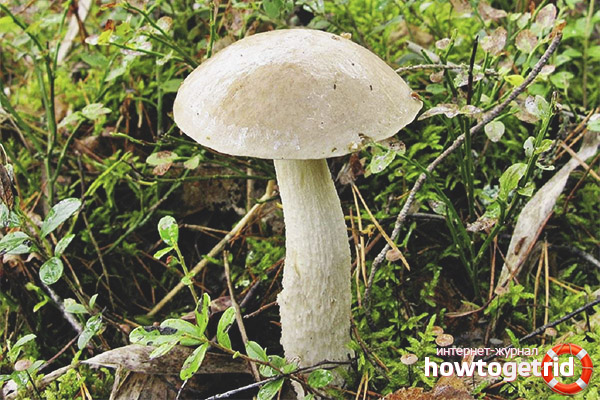The content of the article
White boletus is one of those fungi that belong to the Basidiomycetes department, the Agaricomycetes class, the Boletov family, the Leccinum genus. In Latin, the mushroom is called Leccinum holopus. There are also other names for white boletus: marsh boletus, birch white, marsh. This species is completely safe and refers to fit for human consumption.
Appearance
The size of the cap of this type of mushroom may vary within certain limits, ranging from three to eight centimeters. At a very young age, at the beginning of the view, the shape of the caps of the boletus marsh usually is similar to the hemispherical, but after a certain period of time they become pillow-shaped, and then generally become prostrate caps.Until the end, the caps of the white boletus almost never unfold. This is the main difference of this species from common boletus. The hat is whitish in color, often also with impurities of other color variations. It can also be light gray, beige, with a pink tint.
The circumference of the legs reaches a size of 0.8 to 1.5 centimeters. The closer to the cap, the leg becomes narrower. The stem is white, with slightly visible white scales on its entire surface. With the growth of the fungus, they begin to dry out and become darker in color. The flesh in the leg is softer than in ordinary boletus. The base of the stem is distinguished by the fact that it has a bluish tint of pulp color.
When can I find boletus white
This type of mushroom can be found between mid-summer and mid-autumn. For their ripening mushrooms usually prefer deciduous or mixed forests. They have mycorrhiza for the most part with birch, hence their name - brown birches. The most favorable conditions for their growth are moisture and dampness, so they have a habit to appear at the very edges of the marshes, because another of their name is bogs. The fungus can not be called very productive, but it is also rare.
Taste features of white boletus

White boletus, as everyone knows, is a fungus suitable for human consumption. In various sources, they often speak of their excessive wateriness and unattractive appearance (as opposed to common boletus). But professional mushroom pickers can declare with absolute certainty that they are pretty cute mushrooms, with delicate flesh. There is as much water in a hat of a mushroom as it is in a regular boletus, but it is distinguished by its special softness.
Similar types of mushrooms
Boletus ordinary can be distinguished from its closest relative by the color of the mushroom cap. In this species, it is always much darker. In another way, this mushroom can still be called Berezovik or Obabk. The cap is rather large, it can be up to 15 centimeters in size.
The color of the cap varies greatly. It is both dark brown and light gray, which is directly dependent on the place of growth of the fungus. The form always changes in the process of growth: at first it is hemispherical, when ripe it becomes pincushion. The flesh is colored white or slightly pink, has the same color on the surface of the whole mushroom. The leg length can reach up to 15 centimeters with a circumference of up to three centimeters. It has a cylinder-shaped stem, with a slight expansion closer to the bottom. Painted white with shades of gray and covered with oblong scales in dark color.
Boletus ordinary produce their fruits from the beginning of summer until the end of autumn. Grow mainly in deciduous forests and prefer birch groves. There are especially fruitful years in which you can meet a very impressive amount of this type of mushroom.In the newly grown birch groves, this species shows itself to be one of the first among the other edible mushrooms.
Note! Boletus ordinary can be eaten, but in older fruits it is recommended to cut the tubular layer.
Aspen white is another very white fungus that resembles boletus; it differs in color of pulp noticeably changed in the place of break. Aspen white or aspenik white is a mushroom with a fairly large size. It is also distinguished by the presence of a fleshy cap, the circumference of which sometimes reaches 25 centimeters in diameter. The hat is painted in white, gray-white or gray. The flesh is strong, gets a blue or green tint to the bottom, usually bluish on the break, and sometimes it reaches a deep black color. The leg is high, the bottom is much thicker than the top. It has a white color, along the entire length there are necessarily longitudinal white scales with a brownish tinge.
White-cap boletus whites are also suitable for human consumption; they belong to the list of mushrooms of the second category by the qualities of their taste. Fruits from late summer to early winter, provide mushroom pickers with a relatively short amount of time to search and collect.Young mushrooms of this species are recommended to marinate, and older ones will be a good option to fry or dry.











To send